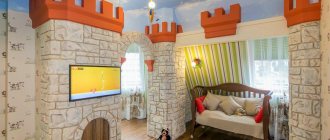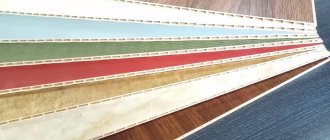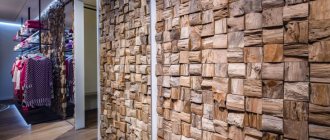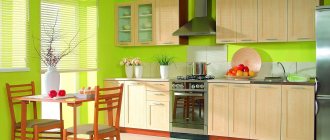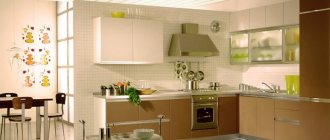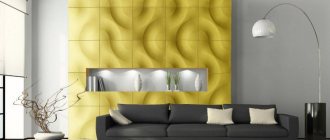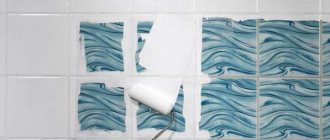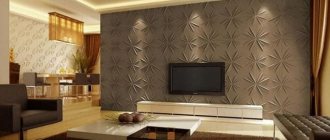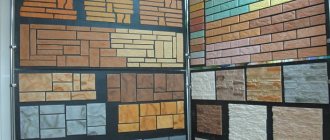Advantages and disadvantages
Due to their specific properties, the panels can be used in places where other materials would suffer. For example, in a bathroom or toilet, plastic panels will fit just right. Or, if repairs need to be done, but there is no money for natural materials, plastic can also come in handy.
PVC panels look good everywhere
But in order for it to look good, not leave the walls and complement the interior, instead of completely breaking it, you need to approach the choice and placement in the house wisely and consistently.
Before we figure out what types of plastic panels there are, where they should be placed, and where it is better to use another material, let’s first look at their basic properties.
The following are useful:
- Low price . This is one of the main advantages - plastic is a cheap material that can still look good, stylish, and interesting.
- Lightness . Typically, wall finishing materials are quite heavy - especially when it comes to tiles or natural wood panels - but plastic does not have this drawback. Even a child can lift one element, therefore, there will be no problems with delivery and mounting on the walls.
- Moisture resistance . One of the materials that is completely insensitive to moisture. Even the joints between the panels can be sealed so that no water gets into them.
This material has a low price
- Easy to care for . Plastic does not like aggressive chemicals, but practically no dust, dirt, or various kitchen liquids stick to it. If you don’t start it, you can simply wash off all the dirt with a cloth soaked in soapy water.
- Resistant to temperature changes . Only the cheapest plastic melts, but nothing is usually made from it in construction. Although expensive PVC panels, of course, should not be placed directly above a gas stove or fireplace.
- Soundproofing . Despite the fact that PVC is usually thin, it dampens sound quite well. Especially if you put a thin layer of insulation between it and the wall.
- Insensitivity to biological stimuli . Plastic does not mold, and the distance from it to the wall is usually so small that parasites cannot grow there, even if we are talking about cockroaches and not rats.
Brick finish
- Variety . Plastic, like any synthetic material, is easy to paint. That’s why you can find all sorts of panels on the market - single-color and multi-color, patterned and plain, with and without patterns. They can also be made with different textures - waves, imitation wood or stone.
- Easy to install . Structural elements are usually equipped with a simple device for coupling of the “spike-lock” type. Even a person who has never undertaken a renovation in his life can put them together. No specific skills are required.
The material dampens sound well
But, of course, not a single material can have only useful properties.
There are also unpleasant ones:
- Lack of resistance to mechanical damage . Plastic is a thin, lightweight material that is easy to damage. You can scratch it even with a brush that is too hard, but a blow inflicted accidentally and casually will probably leave a crack. Therefore, both use and transportation must be careful.
- High probability of buying a low-quality product . It’s difficult to mess up with natural stone, just like with wood - they won’t cost less if you violate the production technique. But plastic will, so there is always a chance of buying panels that will melt, have a very unpleasant smell, or quickly deform.
- Specific smell . Despite everything, even expensive PVC, made according to all the rules, at first emits an odor that may seem unpleasant.
- Difficulty fitting into the interior . Natural materials can be adapted in one way or another to suit any style. But PVC is suitable only for those that are democratic enough to tolerate synthetics - all these are modern styles.
Easy to install
In fact, it makes sense to install plastic panels in rooms where strength is less important than resistance to changes in temperature and humidity.
It is interesting that despite its stability, plastic cannot be placed in rooms where the humidity rises higher than seventy percent, otherwise it will quickly fail.
Plastic wall panels: main characteristics
Plastic wall panels have the following advantages: waterproofness and resistance to direct water.
These products differ:
- Affordable price.
- Easy to install: plastic wall panels are easy to install with your own hands.
- A variety of design solutions.
- Easy to use.
- If necessary, under PVC panels you can hide communications, insulate the room or hide sound insulation.
- Warped or damaged plastic wall panels can be easily replaced with new ones.
This finishing material is much cheaper than many other moisture-resistant facing materials, for example, ceramic tiles. Such products have a wide range of designs printed on the front side. They can be single-colored or multi-colored, mirrored or matte, with regular or textured patterns, etc. There are various options for decorating rooms with plastic panels.
Types of panels
The material for all panels is the same - PVC, also known as polyvinyl chloride. But that doesn't mean they are all the same. There are important nuances - from shape to thickness.
Resistant to temperature changes
Form
Typically, structural elements are rectangular - despite the flexibility of plastic, no one sees the point of giving them a more intricate look. But even rectangles are different:
- Tile. Such panels range in length from thirty centimeters to a meter and their sides are usually equal - the result is small or not very square. You can use them with no less beautiful results than real porcelain tiles. If you take different colors, you can make the wall patterned - stripes, a checkerboard, a simple alternation of colors, or even simple designs. The durability of the result, however, will be much less than that of real tiles - you should not touch the plastic with your elbows or lean something heavy against it.
Plastic does not mold
- " Vonka ". Such panels reach a length of one and a half to two and a half meters, a width of up to thirty centimeters and easily cover the entire space from ceiling to floor. At the same time, they look very similar to real wooden lining - especially if you apply a special coating that imitates wood as the top layer. Less fragile than tiles, they allow you to influence the perception of the room, making it larger or smaller.
- Sheets . The height of such sheets is the same as those made for lining, but the width reaches up to a meter. The result is wide slabs - and you don’t need too many of them to cover a wall in a room.
The choice depends on how much effort you are willing to put into the repair (it is much easier to attach sheets than tiles) and on what visual result you want to get.
Decorating the living room with the proposed material
tip goes well with wallpaper if you choose elements no longer than a meter.
Seam presence and surface finish
In addition to the shape of the panels, they also differ in the presence of a seam:
- Seamless . Unfortunately, they do not fully live up to their name - even the thinnest panels are not able to merge with each other so that the joint is not visible at all. But still, they do their best - the seams, although quite noticeable, do not stand out from the overall canvas, they do not get clogged with dirt or dust, and the wall seems quite uniform.
Wood finish
- With seams . All panels have seams, but these ones are specially highlighted so as to become a kind of decoration. To understand what it looks like, just look at the wooden paneling - there, at the junction of two elements, a special recess is made, because of which the final wall appears striped. It looks stylish in its own way, but only if there is no pattern or design.
The choice is not fundamental and depends solely on the effect you want to get. If you make wood-look panels, then with seams. If it’s a flat wall, then without.
Beautiful bedroom in light colors
The final impression is much more influenced by the way the surface is finished:
- Varnishing . When the panel is ready, it is coated on top with a colorless varnish, which provides it with greater resistance to all external influences. The result is a shiny, glossy surface that slightly reflects in the light. Her colors are rich and bright. It is immediately obvious from the material that it is plastic.
- Lamination . When the panel is ready, it is covered with a special film, which not only protects it from environmental influences, but also gives it a certain color. The result is a matte surface that does not shine and looks quite discreet. This method is used when it is necessary to imitate natural material using plastic.
Classic style kitchen
No finishing method is perfect. The varnish peels off over time, and with constant contact with something it rubs off, losing its glossy shine. The film also peels off over time, can also be worn out, and water can also get under it and then it will swell.
But if the panel gets worn out, it will be enough to simply re-varnish it or re-glue the film - as a result, it will look renewed.
Tip To better imagine what the room will look like in the end, draw it or use special design programs.
Balcony decoration
No. 3. Joint of plastic panels
Depending on the type of joint, plastic panels are:
- seamless;
- suture
Seamless PVC panels can be called very conditionally, since the joint will still be noticeable, but the surface itself will be smooth, because the visibility of the joint between the panels is not provided for by the decor. Of course, you shouldn’t expect that a ceiling finished with such panels will be as smooth as a suspended ceiling or plasterboard, but using special sealants you can achieve very good results from an aesthetic point of view.
Seam panels are distinguished by a special relief joint to give the surface an interesting decorative effect. Often such plastic panels imitate wooden lining . There are also panels for tiles : experts recommend using square elements with a side of 30-98 cm. In addition, you can find plastic panels with rustication ; they are something between seam and seamless panels, but they are not very common often.
Technical nuances of choice
To choose panels that will last a long time, you need to pay attention to their technical characteristics and overall quality:
- Thickness _ Of course, no plastic panel will be very thick - its purpose does not require it. But still, more or less durable products start from two and a half millimeters. Anything that is thinner belongs to the low-priced segment and will crack, not just from an impact - it will be enough just to lean against it poorly.
- Number of stiffeners . The rigidity of the panel is provided by special ribs on which the main surface rests. The more there are, the less likely it is that the plastic will crack due to careless movement. But the more ribs, the more expensive the product.
Stylish living room design
- Appearance. Not so much in the context of compatibility with the interior, but in the context of obvious quality problems. The color of the panel should be uniform, there should be no cracks, chips, or minor defects. No discolored spots, no raised areas or shallow depressions. All little things of this kind may indicate that the panel will very quickly lose its attractive appearance.
- Weight . The stronger the panel, the more it weighs; this is logical, since a lot of additional stiffening ribs are added. To understand which of two panels of the same size will be stronger, simply lift them up at the same time.
- Mutual compatibility . In one batch, the plastic is always the same - it was manufactured under the same conditions, packaged and stored under the same conditions. That’s why you should buy products from the same batch. The same item, but from a different batch, may turn out to be slightly different in color.
There is a wide variety of panels
- Certificates . A serious seller is always able to provide documents for the goods - provided that they exist in nature. They indicate the manufacturer, materials, warranty period, and are stamped for compliance with GOST. If there is no quality certificate, it is better to refuse the purchase - such plastic is unreliable and may be harmful to health.
Tip When checking panels for appearance, choose from the middle of the lot. If a seller wants to cheat and sell a defective product, he would rather shove it deeper and put beautiful presentation elements on top.
Delivery also indirectly affects the choice. When the panels have been selected and purchased, it is better to deliver them home using the services of the same seller - then if something happens to them along the way, it will not be your responsibility.
The material is very easy to install
But if the seller does not provide such a service and you need to drive it yourself, use a taxi. In public transport, fragile plastic is likely to be damaged.
Preparatory work
Having decided on the type and color of decorative plastic panels, you can begin preparing the bathroom surfaces. This procedure is not particularly difficult. During this process, remnants of the previous coating, dirt and dust are removed from the walls and ceiling. Mold and fungal diseases, if any, are eliminated, after which the surface is treated with an antiseptic. The advantages of plastic panels include the fact that the walls under them do not have to be plastered and puttied.
No finishing work can be completed without the appropriate tools, and bathroom renovation with PVC panels is no exception. Therefore, make sure in advance that you have: a screwdriver, a drill, a hacksaw, a construction level, self-tapping screws, a ruler, a marker, materials for the frame or sheathing (beams or metal profiles).
Based on the methods of fastening PVC panels, additional tools are selected. When deciding how to install polyvinyl chloride panels in the bathroom, pay attention to the three most commonly used fixing options:
- classic screws or staples;
- clips;
- glue.
Any of these methods can be implemented independently by studying all the available information.
Aesthetic side
Long service life is not everything. If the panels are ugly, do not fit into the interior, and do not please, then their reliability will rather irritate them. There are several important factors to consider.
Room
Different rooms require different handling of plastic.
Bathroom interior
First of all, the bathroom. The most common place to use plastic panels. This is due to the fact that they are cheaper than tiles, but they withstand humidity very well. Designer delights in the bathroom do not catch on with everyone; practicality takes precedence over the desire to make it expensive and stylish, which is why plastic can be seen often.
To make it look good, you need to combine it with the color of the bathtub (if it is not white, then any color will do), with the color of accessories, such as a rug and curtains. Most often, shades of green, warm light shades like beige and peach, blue, or designs that somehow echo the theme of water procedures are used here.
Then - the toilet . Not everyone has the inspiration to choose a style for a toilet, and plastic is cheap, holds moisture and can hide pipes, for which wallpaper, for example, is useless. The colors used here are the same as in the rest of the house, or as neutral as possible.
The third most popular place for plastic panels is the kitchen . Not every material can withstand constant changes in temperature and humidity. Tiles are expensive, glass and metal are too, and plastic copes well with loads. In the kitchen it can be combined with wallpaper or with the same tiles to decorate a small work area.
Colors - in combination with the rest of the interior.
In the living room and bedroom, plastic panels are rarely used, since even painting the walls is easier, cheaper and more suitable for the very concept of living rooms. If the idea seems interesting to you, you can always combine plastic with another material and fake it to look like wood or stone. It will look good in combination with wallpaper. It will look best in American style and other democratic styles.
Classic style bathroom
PVC can also be used on the balcony - especially if you are going to use it as another storage room. PVC withstands moisture well and can last for about a decade, even if you don’t like to close the windows on your balcony.
General impression
Having decided in which room to place the panels, you can move on to other questions: how to arrange them and what color to paint them.
Green panels in the kitchen interior
- Horizontal arrangement . Suitable for tall, narrow rooms that seem too small. Horizontal stripes on the walls will help to visually enlarge the space, make the ceiling lower and the walls seem wider.
- Vertical arrangement . Suitable for low, wide rooms that seem very flattened. Vertical stripes on the walls will help visually reduce and elongate the space in height, so that it appears larger.
- Mosaic arrangement . Absolutely neutral in nature, but depending on the pattern used, it can have a different effect on the surrounding space.
Horizontal arrangement of material
It is also important to consider how the color of the panels will match the color of the floor and ceiling.
- Light walls, dark floor and ceiling. It is good to combine with a horizontal arrangement, since this combination is suitable for rooms that are too narrow and tall. The dark ceiling seems to press down the height, making the room lower, and the floor enhances this impression.
- Light walls, dark floor, light ceiling. Well suited for low narrow rooms. Makes them visually wider, increases the space and seems to stretch it upward.
- Light walls, light floor, dark ceiling. This combination looks a little strange, but can give a strange effect - it will seem that the room narrows slightly towards the ceiling.
Minimalist room style
- Dark walls, dark floor and ceiling. A very controversial decision, suitable only for pompous ornate styles and truly large rooms, since it makes them visually noticeably smaller. It is better not to do this in a small room, as it will feel like the walls are squeezing anyone who enters.
- Dark walls, light floor and ceiling. Such a room seems to stretch upward. Well suited for wide ones with low height.
- Dark walls, light ceiling, dark floor. Such a room stretches upward even more. If you decorate a narrow room like this, the person entering will feel as if he has fallen into a well.
Mosaic arrangement
In addition to the combination, the shade of color also matters:
- Light warm shades . They give the room coziness, but make it visually a little smaller. Well suited to classic romantic styles.
- Light cool shades . An ideal solution for loft and minimalism - which, being modern, fully accept plastic. Makes the room more spacious, gives it a echo, but also some coldness.
- Dark warm shades . Quite acceptable, cozy, and make the room a little smaller. Pairs well with wooden furniture.
- Dark cool shades. They are acceptable only in some styles, and even then - serious ones, usually requiring natural materials and restraint. Plastic doesn't go well with them.
Using PVC for walls and ceilings
And, of course, from a purely practical point of view, light colors are harder to wash, any dirt is more visible on them, and over time they can darken or turn yellow.
Dirt is less visible on dark flowers, but they can fade, especially if placed in the sun.
Particular attention should be paid to the joints: if fat becomes clogged in them, this will not benefit the entire structure. You can use a rubber spatula to clean them.
Bright and beautiful hallway
PHOTO: Secrets of choosing plastic
PVC panels
Choosing panels for finishing
Features of PVC panels
The advantages of the panels include:
- their low cost;
- environmental safety under adequate conditions of use;
- resistance to fungi and mold;
- long service life;
- no deformation when humidity and temperature change;
- speed and ease of installation;
- the ability to place communications under the panels;
- installation of insulation and sound insulation;
- a large selection of design solutions for PVC panels in the interior;
- easy care.
The disadvantages include such properties as:
- extremely low impact resistance;
- low wear temperature. Therefore, placement near hot springs is not possible;
- loss of color due to direct exposure to bright rays.
Finishing with PVC panels in an apartment: scope of application
As already mentioned, PVC panels are a universal finishing material. It can be used: for exterior decoration;
- for internal repairs;
- for walls;
- for ceilings;
- for bathrooms, baths, kitchens and other rooms where temperature and humidity are unstable.
It is very interesting to use PVC panels for the kitchen to finish the apron and the area near the sink in the kitchen.
It is undesirable to use standard panels for operating surfaces at subzero temperatures, since in frost the plastic loses its strength and becomes brittle under direct physical impact. For this purpose, a special type of material is produced. If you need to hide pipes or wiring, just build a box on the frame.
